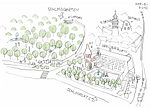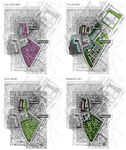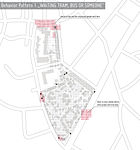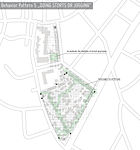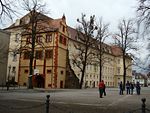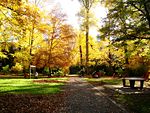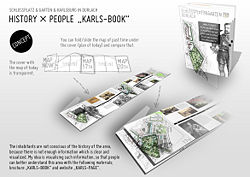Schlossgarten Durlach
---> back to overview of Case Study List
Short Introduction to the Area of Study
Durlachs‘ Schlossgarten is the oldest garden-park in the city of Karlsruhe. This garden belonged to the Karlsburg castle, which was a landmark of the old emperors of Baden since 1563, when Markgraf Karl II moved his residence to Durlach. Firstly, a renaissance-style garden was built, which then experienced major replanning since the Baroque until today. Since fall 2007 the garden has belonged to the city of Karlsruhe, with redevelopment starting soon. A new lapidary has been built, in the place which had been an outhouse. The Schlossplatz was originally a part of the garden and works today as a community square where recreational events are held. It was conceived in such way, that the usable area is kept the biggest as possible, with only a single fountain as decoration.
I myself have been using this place for three years, since it’s very close to where I live. It is personally quite interesting to analyse such a place, which lies in the center of a town and was planned and thought for its inhabitants, since in my homeland Japan such places are very scarce, but in my opinion urgently needed.
Exercise 1: Sketching the Landscape
Time frame: October 25 - November 15, 2011
Student activities:
- Creation of analytical drawings and sketches
- Presentation of results
Please upload a selection of your drawings/sketches/mental maps and add them to the image gallery
Sketches and Drawings
Exercise 2: Landscape Layers
Time frame: November 15 - 29, 2011
- time based changes and 'landscape biography', and/or:
- topography, open spaces, built, green, traffic and water structures on different layers. *Definition of zones with coherent character
- Description of this character.
Character of Schlossplatz: Schlossplatz is very open, visible and central place in Durlach. Due to its traffic situation, with cars, tram and busses driving through and the shops that are located there it’s the place which they experience everyday, where they meet each other. People coming there usually stay shortly to wait the tram or to buy bread etc. When there is an event going on there, the place really becomes the heart of town, with all people converging there.
Character of Schlossgarten: Schlossgarten is hidden and closed, like a private garden, because it is staying on a lower level as road and has wall, moreover there are many old and large trees which contribute to this atmosphere. The garden is never full but the citizens stay cosy and longer.
Please publish your findings here
Exercise 3: Behaviour Patterns
Time frame: December 6 - 20, 2011
- How do people behave in this area? How do they use the space? What is important for them?
- Observation of study area, interviews with local people and mapping of use patterns.
- Preparation of short presentation
I analysed may case study area with seven behaviour patterns: waiting, walking, sunbathing/doing picnic, sitting on bench, doing sports, playing and talking. They are typical behaviours of residents which I see everyday there.
Generally, I see not so much youth in both areas, except midsummer and Christmas time. I suspect that the youth prefer go to Karlsruhe city, because Karlsruhe is more attractive to them than Durlach, there are more possibilities of shopping, eating and drinking. Old people, family and children visit this area rather than youth and particularly the Schlossgarten is used almost just by such residents. It is an advantage for small children, school kids who have started to cycling or old people who need some physical movement everyday. They can practice their activities without disturbance.
Now it is advent time in Germany, therefore there is a „medieval“ Christmas market going on on Schlossplatz. Unfortunately, the weather has not been good lately, but there are lots of people there, who are not only inhabitants of Durlach, but also people from Karlsruhe or from neighbor towns. This one month people visit the Christmas market everyday and enjoy hot wine and some german food. At the weekends, fire acrobatic shows take place and a whole 100 kg hog is grilled over of the fire. Vendor of Christmas market wear also medieval clothes and there are some special games for children.
http://www.durlacher.de/galerie/2010/november/26-mittelalterlicher-weihnachtsmarkt.html
Exercise 4: Communication Concepts
Time frame: December 19, 2011 - January 17, 2012
- Based on the different landscape assessment approaches students will develop a communication concept for their area of study
- Which measures would be necessary for enhancing the awareness for the area?
- Students are free to choose their method.
“Know it, use it and love it!”
My case study area “Schlossplatz and Garten in Durlach” is a very intimate place for the residents but has also the very historical background. I think this historical aspect is the most important point of this area. Although the area is very important for the residents, I have a feeling the people are not conscious of this area and its history, because there is not enough information which is clear and visualised. I focused on trying to find ways how the residents could made conscious to the place where they are living and which they experience every day.
My idea is to develop the communication between; 1. history of the area and people, people means here “all residents“ 2. people and people (residents and residents, residents and non-residents) 3. people and the place.
Therefore I think the information which I want to communicate should be presented clear, easy to understand, and attractive, as this information is not for some special people, but for all inhabitants, old people, youths and children, everyone. And it’s also significant that the people can choose if they want to get such information or not. To communicate there are two methods, one is the so-called “Hard approach”, it’s like changing the design of the area or building some new objects, and so on, they are in other words “direct approaches”. Another one is the so-called “Soft approach”, it could be called “indirect approach”, like some events, education or an information system etc. So I have chosen the “Soft approach” as a communication method for this area, because in my opinion it is not necessary that someone makes a conspicuous impact or a big campaign in this area. Therefore I choose the following two media materials; “brochure” and “website“. These materials are very common today, so I think they should be practical and sustainable at the same time.
Please publish your findings here
I call the broschure “Karls-book”, since the first king, Karl II, built the castle “Karlsburg” and it could be funny if the king inform the people about the history as if he were a good friend. The web site is called “Karls-page”, more interactive things could be presented on this website than in the book.
The “Karls-book” is a free book, which the inhabitants can get in the castle “Karlsburg” , in the town hall or in other local shops in Drulach. With this book they can find out about this place, its history or which events will be going on there. The book has a “zigzag” form and the cover with the today’s map is transparent, so people can fold and slide the old maps, which are inside, under the cover and compare them. This book would be supported by people from local shops. The back site of the book could be used as events calendar or for advertising of local shops.
The “Karls-page” would be also supported by the residents. The visualised information would be presented on this website and the user can share those information very quickly. The general information: visualised location, vegetation, residencial area and the historical information would be presented using different methods; slideshow, 3D animation, old plan etc. The Karls-page is connected with face book, twitter or such social networks. In addition the people can suggest and create some events on this place. There are certain many creative residents, moreover there are a technical university, an art university, a music university and a college of design in Karlsruhe, the inhabitants could combine with those university or students. Further the people can download maps of past time and children could hunt the “Treasures” which exist at this place yet.
I think the residents could know and use this place better with such materials and ultimately they would be more interested in their “Everyday landscape”.
Image Gallery
References
* Please make sure that you give proper references of all external resources used.
* Do not use images of which you do not hold the copyright.
* Please add internet links to other resources if necessary.
[[Category:Everyday Landscapes Working Group About categories: You can add more categories with this tag: "", add your categories



